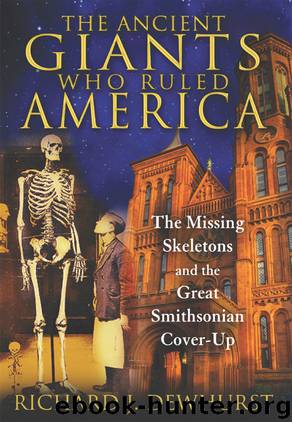The Ancient Giants Who Ruled America by Richard J. Dewhurst

Author:Richard J. Dewhurst
Language: eng
Format: epub, pdf
Tags: Spirituality/Ancient Mysteries
Publisher: Inner Traditions / Bear & Company
Published: 2013-12-05T16:00:00+00:00
Fig. 6.3. A carving of an otter. Illustration from Ancient Monuments of the Mississippi Valley by Ephraim Squier and Edwin Davis
In shape the village was roughly circular consisting of two parallel stockades, the outer one 450 feet in diameter and the inner 430 feet. This fact was ascertained by the finding of rows of “post molds,” each mold easily identifiable because of the darker soil in it as contrasted with the lighter surrounding subsoil. There was a plaza area in the center of the village. Refuse pits filled with debris were here and there.
The Indian huts were arranged in a rough circle just within the stockade, and, as shown by the post molds, were from 18 to 20 feet in diameter, having a very narrow entrance less than two feet wide. Inside was a fire pit. Attached to or very near each hut, was a bark-covered, pear-shaped food storage pit. It is believed that tender young saplings were placed in each post hole, arched toward the center, tied at the top, and the whole covered by bark. The staple food seems to have been maize, probably grown in small plots outside the village. Other common foods were fish and mussels, and the meat of animals, particularly deer and elk.
The streams were then clean and sparkling, and fish were abundant. In the smaller creeks were speckled trout; in the larger ones yellow and black bass, white perch, buffalo fish, and mullets. In the rivers were pike, sturgeon, and salmon. Some specimens were as much as four feet long and 35 pounds. Other animals have been noted in connection with the archaeological excavations at the site of the late Prehistoric Indian village near Blairsville.
Other animals known to have been here were gray and black squirrels. The number of panthers is thought to have been rather few. Even more scarced were the wood buffalos, larger than their Western kin (nearly a ton in weight), having no hump and being more nearly black in color, with shorter hair and large hind quarters. The extensive and lucrative fur trade caused the beaver to disappear from the local area.
Download
The Ancient Giants Who Ruled America by Richard J. Dewhurst.pdf
This site does not store any files on its server. We only index and link to content provided by other sites. Please contact the content providers to delete copyright contents if any and email us, we'll remove relevant links or contents immediately.
| Ancient & Controversial Knowledge | Ghosts & Hauntings |
| Hermetism & Rosicrucianism | Magic Studies |
| Occultism | Parapsychology |
| Supernatural | UFOs |
| Unexplained Mysteries |
Animal Frequency by Melissa Alvarez(4395)
Sigil Witchery by Laura Tempest Zakroff(4181)
Real Magic by Dean Radin PhD(4073)
Fingerprints of the Gods by Graham Hancock(3943)
Aleister Crowley: The Biography by Tobias Churton(3589)
Journeys Out of the Body by Robert Monroe(3572)
The Rosicrucians by Christopher McIntosh(3467)
Alchemy and Alchemists by C. J. S. Thompson(3451)
Mysteries by Colin Wilson(3397)
Hitler's Monsters by Eric Kurlander(3269)
The Hatha Yoga Pradipika (Translated) by Svatmarama(3233)
John Dee and the Empire of Angels by Jason Louv(3132)
Wicca: a guide for the solitary practitioner by Scott Cunningham(3127)
Infinite Energy Technologies by Finley Eversole(2939)
Book of Life by Deborah Harkness(2869)
Dark Star Rising by Gary Lachman(2830)
The Book of Lies by Aleister Crowley(2802)
Aliens by Jim Al-Khalili(2787)
To Light a Sacred Flame by Silver RavenWolf(2768)
